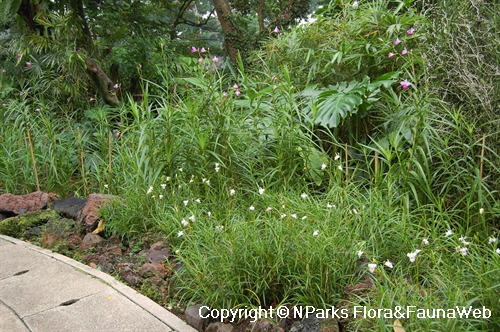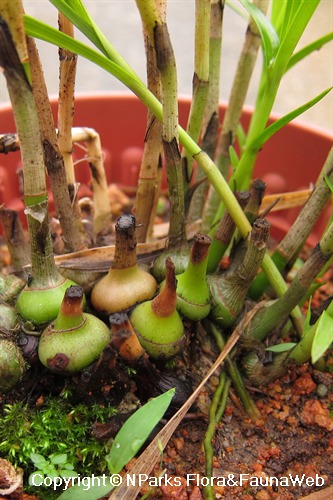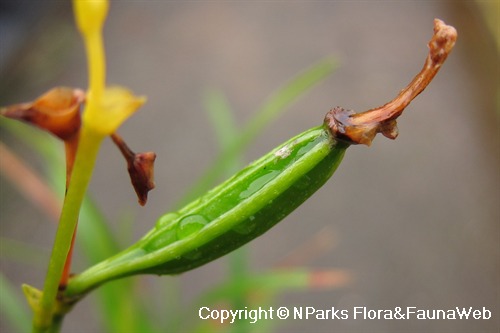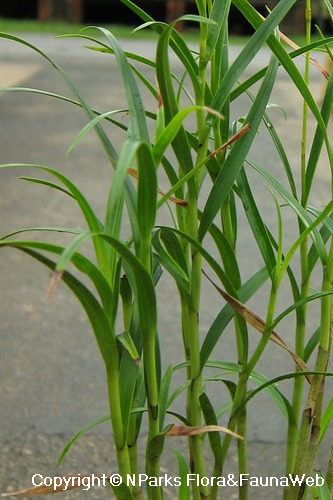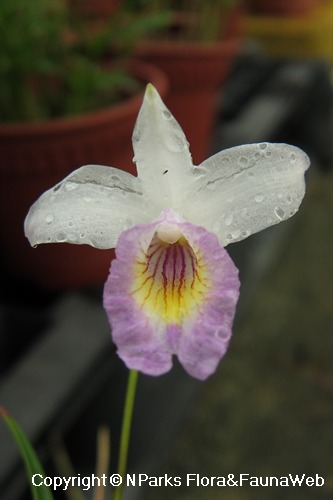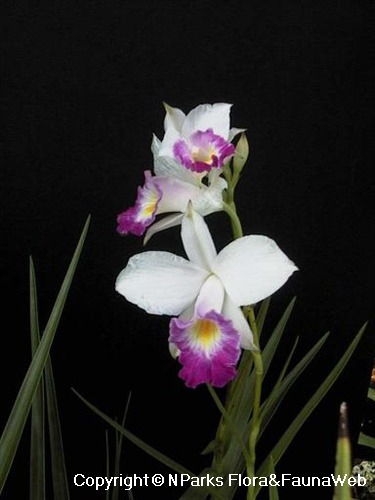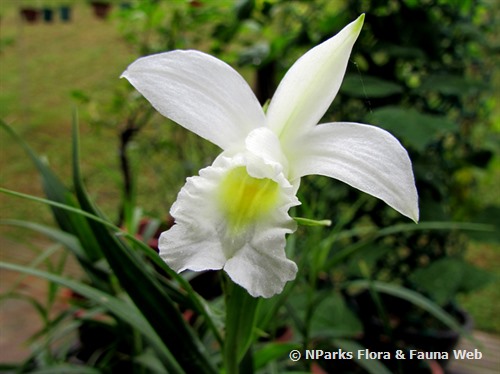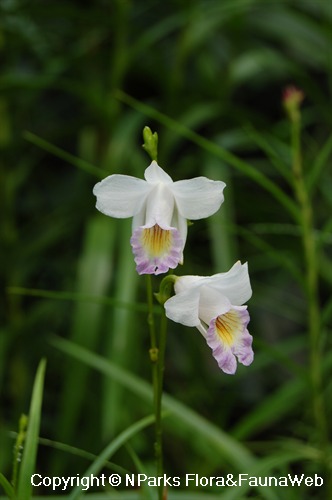
Name
Classifications and Characteristics
| Plant Division | Angiosperms (Flowering Seed Plants) (Monocotyledon) |
|---|---|
| Plant Growth Form | Herbaceous Plant |
| Lifespan (in Singapore) | Perennial |
| Mode of Nutrition | Autotrophic |
| Plant Shape | Dwarf |
| Maximum Height | 0.3 m to 0.6 m |
Biogeography
| Preferred Climate Zone | Tropical |
|---|
Description and Ethnobotany
| Growth Form | Evergreen, terrestrial orchid with erect growth habit. It looks like a smaller version of Arundina graminifolia, but flowers are lighter in colour. |
|---|---|
| Foliage | Smooth, dark green leaves are narrow and linear with parallel leaf venation and entire leaf margin (13 cm long, 0.5 cm wide). Alternate leaves are arranged in 2 rows on either side of the stem. |
| Stems | Stem resembles that of bamboo. The base of the stem is swollen and has a bulb-like shape. |
| Flowers | Small, white flowers have a pink tubular lip (the bottom petal). The lip has a yellow throat marked with red streaks. Flowers are produced throughout the year. |
| Fruit | Fruit is a cylindrical, ridged pod. |
| Cultivation | This cultivar will grow and flower best in full sun or very light shade. If possible, choose an east-facing window or plot to maximize exposure to morning sun and minimize intense afternoon sun that may cause heat stress. It should be planted in fertile, well-draining soil that is rich in compost. Thoroughly water potted plants until excess flows out once a day for plastic pots, twice a day for clay pots. In the absence of rain, plants grown outdoors should be watered in the morning and evening daily. |
| Etymology | The genus "Arundina" is derived from the Latin word for reed ("arundo"). Species in this genus often have stems that look like reeds. |
Landscaping Features
| Landscaping | This cultivar is ideal for container plantings and will grow well on a sunny patio. It can also be planted as a border along pathways. |
|---|---|
| Desirable Plant Features | Ornamental Flowers, Ornamental Stems |
| Landscape Uses | General, Flowerbed / Border, Container Planting |
| Thematic Landscaping | Zen / Minimalist Garden |
Fauna, Pollination and Dispersal
| Pollination Method(s) | Abiotic (Self-Pollinated) |
|---|
Plant Care and Propagation
| Light Preference | Semi-Shade, Full Sun |
|---|---|
| Water Preference | Lots of Water |
| Rootzone Tolerance | Fertile Loamy Soils, Well-Drained Soils |
| Maintenance Requirements | Moderate |
| Propagation Method | Seed, Division |
| Propagation Method Remarks | Propagate by seed or dividing clumps. For seed propagation, place a bag over the seedheads to collect seed. Seeds lose viability quickly, so plant them soon after collection. |
Foliar
| Foliage Retention | Evergreen |
|---|---|
| Mature Foliage Colour(s) | Green |
| Mature Foliage Texture(s) | Smooth, Glossy / Shiny |
| Foliar Type | Simple / Unifoliate |
| Foliar Arrangement Along Stem | Alternate |
| Foliar Shape(s) | Non-Palm Foliage (Linear) |
| Foliar Venation | Parallel |
| Foliar Margin | Entire |
| Foliar Apex - Tip | Acute |
| Foliar Base | Truncate / Square |
| Typical Foliar Area | Microphyll ( 2.25cm2 - 20.25 cm2 ) |
Non - Foliar and Storage
| Stem Type & Modification | Herbaceous |
|---|---|
| Root Type | Underground (Fibrous Root) |
| Specialised Storage Organ(s) | Aboveground |
Floral (Angiosperm)
| Flower & Plant Sexuality | Bisexual Flowers |
| Flower Colour(s) | Pink, White |
|---|---|
| Flower Symmetry | Bilateral |
| Flower Size - Remarks | 2 - 3 cm |
| Flower Lifespan on Plant | 1 Day |
| Flowering Habit | Polycarpic |
Image Repository
Others
| Master ID | 395 |
|---|---|
| Species ID | 1691 |
| Flora Disclaimer | The information in this website has been compiled from reliable sources, such as reference works on medicinal plants. It is not a substitute for medical advice or treatment and NParks does not purport to provide any medical advice. Readers should always consult his/her physician before using or consuming a plant for medicinal purposes. |

